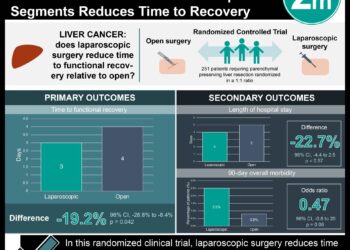Pediatric post-operative intussusception more common in open surgery
Image: PD/US Navy
1. Small bowel intussusception is the most common type of post-operative intussusception (POI) following abdominal interventions. However ileocolic intussusception is also prevalent after non-abdominal procedures.
2. Minimally invasive abdominal surgery may have a lower risk of pediatric post-operative intussusception.
Evidence Rating Level: 2
Study Rundown: Post-operative intussusception is a rare complication without any clear underlying cause. Its recent epidemiology in the pediatric population, especially in regards to minimally invasive surgery, has not been evaluated. This study is limited by the comparably low number of POI cases identified and its restriction to a single center. Nonetheless, the authors achieved statistically significant results, demonstrating that ileocolic intussusception is as prevalent as ileoileal and jejunojejunal types (more common overall) after non-abdominal surgery. Clinically, this is relevant because ileocolic intussusception can be reduced nonoperatively using air contrast enemas, while small bowel intussusception generally require surgery. Additionally, non-abdominal surgery POIs that were unrelated to gastrojejunostomy tubes differed demographically from idiopathic intussusception, which has a higher rate of small bowel intussusception and typically occured in a younger age group.
Click to read the study in Journal of the American College of Surgeons
Relevant Reading: Postoperative Intussusception in Children
In-Depth [retrospective review]: A total of 822 cases of intussusception were identified over the course of 13 years. Among them, 22 cases were post-operative. A little over half were abdominal interventions and the rest were extra-abdominal surgeries. All POIs following abdominal procedures were associated with the small bowel. Fifty percent of the non-abdominal cases resulted in an ileocolic intussusception. This variance in the type of intussusception based on procedure location was statistically significant (p=0.01). Only one case of POI was identified after a laparoscopy, specifically as an incidental finding with swift spontaneous resolution. The difference in POI incidence between laparoscopic and open abdominal procedures was statistically significant (p=0.036). No POI cases were identified in association with extra-abdominal minimally invasive interventions that used carbon dioxide insufflation. Additionally, this study characterized patient demographics, identifying that average age of POIs was 4.7 years old with a predominance in boys. Most were diagnosed within one week of the intervention.
By Asya Ofshteyn and Allen Ho
More from this author: CTA as an alternative to angiography for blunt cerebrovascular trauma detection, Low infection risk with neurologic endovascular procedures, Post-operative PTSD intervention improves physical outcomes in trauma patients, Hep B reactivation common after liver resection for HBV-related hepatocellular carcinoma
© 2013 2minutemedicine.com. All rights reserved. No works may be reproduced without written consent from 2minutemedicine.com. Disclaimer: We present factual information directly from peer reviewed medical journals. No post should be construed as medical advice and is not intended as such by the authors or by 2minutemedicine.com. PLEASE SEE A HEALTHCARE PROVIDER IN YOUR AREA IF YOU SEEK MEDICAL ADVICE OF ANY SORT. Content is produced in accordance with fair use copyrights solely and strictly for the purpose of teaching, news and criticism.







